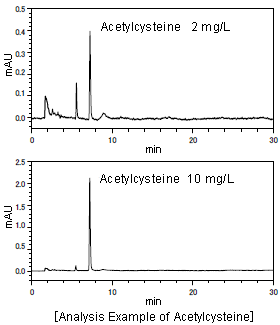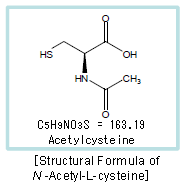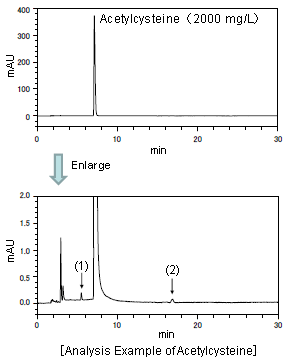Analysis Example for Drugs in the Japanese Pharmacopoeia Sixteenth Edition (Acetylcysteine)
More than 100 drugs as well as their test methods were added to the Japanese Pharmacopoeia Sixteenth Edition, which became effective in April of 2011.
Presented here is an HPLC-UV method for analysis of one of the newly listed items, acetylcysteine, as well as related substances. First, the system suitability was confirmed based on the specified test conditions and then the test for related substances was performed. In the test for related substances, it is necessary to analyze very small peaks and therefore, detector performance becomes an important factor. The Hitachi high-speed liquid chromatograph "Chromaster" 5410 UV Detector achieves low noise and low drift, allowing for the required high sensitivity analysis.
In this application, a general reagent acetylcysteine was used as the model sample of this drug.
Confirmation of System Suitability


Analytical Conditions
| Column | HITACHI LaChrom C18 (5µm)(4.6mmI.D. x 250mm) |
|---|---|
| Elluent | Dilute phosphoric acid (1→2500)/Acetonitrile =19/1(v/v) |
| Flow rate | 1.1 mL/min |
| Column temperature | 40°C |
| Detection wavelength | UV 210 nm |
| Injection vol. | 10 µL |
* Adjust the flow rate so that the retention time of acetylcysteine is about 7 minutes.
System Suitability
Under the system suitability for purity (6) related substance in the Japanese Pharmacopoeia Sixteenth Edition, the "Test for required detection," "System performance," and "System reproducibility" are specified. The specification values and the analysis results obtained are summarized below. The results indicate that the requirements for all items were satisfied.
| Item | Specification values for system suitability | Analysis results | |
|---|---|---|---|
| Test for required detection | (Peak area of 2 mg/L/Peak area of 10 mg/L) x 100(%) | 15 - 25 | 19.6 |
| System performance | Number of theoretical plates (10 mg/L) | NLT 15000 | 17554 |
| Symmetry factor (10 mg/L) | NMT 1.5 | 1.29 | |
| System reproducibility | Relative standard deviation of peak area(n = 6)(10 mg/L) | NMT 2.0% | 0.58% |
Test for Relative Substances

Analytical Conditions
| Column | HITACHI LaChrom C18 (5 µm) (4.6 mm I.D. x 250 mm) |
|---|---|
| Eluent | Dilute phosphoric acid (1→2500)/Acetonitrile = 19/1 (v/v) |
| Flow rate | 1.1 mL/min |
| Column temperature | 40°C |
| Detection wavelength | UV 220 nm |
| Injection vol. | 10 µL |
*Adjust the flow rate so that the retention time of acetylcysteine is about 7 minutes.
Multiple peaks representing the related substances of acetylcysteine were found.
Each of the very small peaks, (1) and (2), has an area equivalent to about 0.03% of the area of acetylcysteine (2,000 mg/L). In this example, the S/N of these peaks are respectively 28 and 13, indicating that sufficiently reliable peak heights and areas are obtained.
Test for Related Substances
Under the purity (6) related substance in the Japanese Pharmacopoeia Sixteenth Edition, two types of numerical values are specified for the peaks other than acetylcysteine peak. The specification values and the analysis results obtained are summarized below. The results indicate that the requirements for all items were satisfied.
| Specification values for related substances | Analysis results | |
|---|---|---|
| Areas of peaks other than acetylcysteine | Each related substance is NMT 0.3% | Each related substance is NMT 0.16% |
| Total is NMT 0.6% | Total is NMT 0.31% |
(2,000 mg/L, 10 µL injection)
NOTE:
These data are an example of measurement; the individual values cannot be guaranteed.
The system is for research use only, and is not intended for any animal or human therapeutic or diagnostic use.
In order to read a PDF file, you need to have Adobe® Reader®
